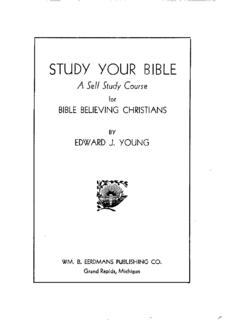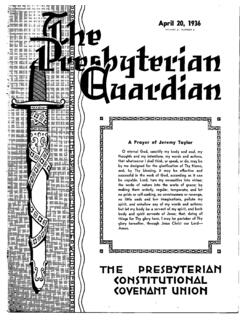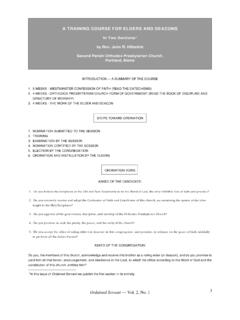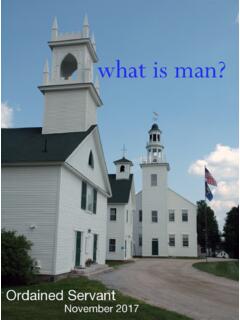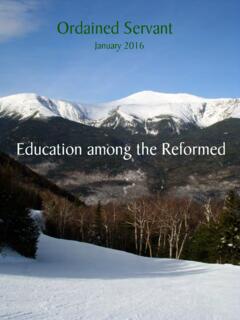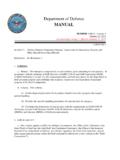Transcription of Vol. 4, No. 3 Cover - Orthodox Presbyterian Church
1 Vol. 4, No. 3OS E R V A N TDAINEDP ublished byThe Christian Education CommitteeofTHE Orthodox Presbyterian CHURCHJuly, 1995 ORDAINED SERVANTS tatement Of PurposeOrdained Servant exists to provide solid materials for the equipping of office-bearers to serve more faithfully. Thegoal of this journal is to assist the ordained servants of the Church to become more fruitful in their particular ministryso that they in turn will be more capable to prepare God's people for works of service. To attain this goal OrdainedServant will include articles (both old and new) of a theoretical and practical nature with the emphasis tendingtoward practical articles wrestling with perennial and thorny problems encountered by Policy1. Ordained Servant publishes articles inculcating biblical presbyterianism in accord with the constitution of theOrthodox Presbyterian Church and helpful articles from collateral Reformed traditions; however, views expressedby the writers do not necessarily represent the position of Ordained Servant or of the Ordained Servant occasionally publishes articles on issues on which differing positions are taken by officersin good standing in the Orthodox Presbyterian Church .
2 Ordained Servant does not intend to take a partisan stand,but welcomes articles from various viewpoints in harmony with the constitution of the Orthodox for the Christian Education Committee of the Orthodox Presbyterian Churchunder direction ofDr. James Gidley, Mr. David Winslow, Rev. Larry Wilson and Rev. Jack Petersonby PLEROMA PRESS, Box 242, Carson 58529 Address correspondence to the editor: G. I. Williamson, 119 Normal College Ave., Sheldon IA 51201 Subscription price is $12 per year. Ordained Servant will be published from 2 to 4 times peryear in the present format. Do not send subscriptions to the editor but to PLEROMA part of this Journal is to be reproduced without permission from the : Vol. 4, No. 3 Book Review, by the to All What is Due Them (Part 1), by David G. Hagopian, Christian Soldier and Humble Servant Models, by Robert B. Erasures, by Peter Stazen Atonement, by the Ordained Servant Vol. 4, No. 349 Please send all materials intended for possible publication inOrdained Servant to the Editor, G.
3 I. Williamson, 119 NormalCollege Ave., Sheldon IA send all requests for additional copies, or back issues,to the Publisher, Stephen Sturlaugson, PLEROMA PRESS, Box242, Carson 5852950 Ordained Servant Vol. 4, No. 3 Book ReviewThe Liberation: Causes and Consequences,Cornelis Van Dam, editor, Premier PublishingWinnipeg, 1995, 167 pp. $ (Canadian).I found it difficult to write this review. Thereason is not the length of this book, or any lackof clarity in it. It is rather the fact that the contentof the book is already a kind of report or summa-tion and it is difficult to summarize a summary!Nevertheless, because of the importance of whatthe Canadian Reformed Churches call The Lib-eration I have attempted to do book consists of an edited version ofthree major addresses given at meetings held inBurlington, Ontario, in October of 1994. Theoccasion was the fiftieth anniversary of the eccle-siastical Liberation that occurred in the Nether-lands in 1944. Included with each of the threeaddresses is an edited version of the discussion with questions and answers that one of the speakers Dr.
4 J. Faber was an eyewitness of the events that took placea half century ago. He was asked to deal with thedoctrinal began by emphasizing Abraham Kuyper sinfluence in the Reformed Churches in the Neth-erlands [RCN] in the 30s. Kuyper had spoken ofthe image of God in a broader and in a narrowersense, of common and special grace, of a visibleand invisible Church , an external and internalcovenant, and so on. In those days, says Faber,there were lively polemics about the pluriformityof the Church , about God s covenant and aboutself-examination and so on. In many respects, he continues, they were a continuation of discus-sions that had taken place after the union of 1892between theologians of the Secession of 1834 andof the Doleantie of 1886. These differences founda peaceful solution in a compromise-formula atthe General Synod of Utrecht [in] 1905. Thisformula was framed in such a way that Kuyper sviews while recognized as legitimate were notseen as the only views allowed in the General Synod of Sneek convened justbefore the outbreak of World War II.
5 In violationof the Church Order, it continued until April of1943. Toward the end of this period in 1942 itissued doctrinal statements about five topicswhich had been hotly debated during the 30s. Themost important, says Dr. Faber, was its state-ment on the covenant of grace. While it reiteratedpart of the 1905 compromise-formula it thenadded the following statement: ..the seed of the covenant, by virtue of thepromise of God, must be held to be regeneratedand sanctified in Christ until, upon their growingup, the opposite should become apparent fromtheir conduct or doctrine. And that is not all! This was accompanied byan explanatory statement called Toelichting (Elu-cidation). It required examine candi-dates for the ministry on these doctrinal pointsand to assure themselves that the candidatesagreed with Synod s pronouncements. It was, ineffect, the imposition of a fourth Form of main issue concerned the relation be-tween God s election and God s covenant.
6 Did Godestablish his covenant with the elect (or withChrist, and the elect in him), or did he establish hiscovenant with Abraham and his seed. Was it acovenant of election, or a covenant of promise?Faber says Kuyper and other prominent theolo-gians of the Doleantie were supralapsarians. Intheir thought the doctrine of the covenant wasdominated by election. For this reason they spokeof the essential or internal covenant as made onlywith the elect. In opposition to this Faber quotesthe well-known text in Deuteronomy 29:29 Thesecret things belong to the Lord our God; but thethings that are revealed belong to us and to ourchildren for Faber says The covenant isnot a secret thing like election but a establishes his covenant with believ-ers and their children, all their as well as Jacob. Flowing from Kuyper s view of the covenantwas his view of baptism whereby the position ofall those who are baptized may be called the covenant position. Those who op-posed the imposition by Synod of this view wereunwilling to speak of a twofold covenant, or abaptism that did not, in every case, signify a bonafide covenant position.
7 Faber rightly points outthat the Paul (in I Cor. 7:14) says all the childrenof believers are holy. He says this term holy means set apart from the godless world and dedi-cated to God. And in this there is no assumption,or presumption at all. Those who let the doctrine of the covenant bedominated by the doctrine of election also made a distinction between a conditional and an uncon-ditional promise. The conditional is an offer. Theunconditional is a prediction. It was precisely this scholastic distinction says Faber, that confusedReformed people. Those who refused to submit toSynod s pronouncements maintained that there isno prediction here but only the promise of , as the form for baptism says, all cov-enants contain two parts a promise and an obli-gation. The trouble was, says Faber, that underthe Synod s statement baptism became a sign andseal of internal to be present inOrdained Servant Vol. 4, No. 3 51 Book Reviewthe heart of every child (and yet not certain to bepresent).
8 Prior to 1942 this view was tolerated inthe Church but henceforth it was to be Klaas Schilder, and others, refused to end result was that he and others weredeposed from office. This, in turn, precipitated the Liberation. At this point questions were asked and an-swered. Perhaps the most important was this:Was it the binding that was intolerable? Or was itthe doctrine itself? Faber s response is clear andemphatic: it was the binding. He said he wouldnot throw a man out of the Church who hadKuyper s about the present state of the CRC inrelation to these things, Faber said the CRCdeviations are in a certain way much deeper. Itis not a problem now of a Kuyperian concept butof the new hermeneutic that leads to all positions. IIThe second speaker was Dr. J. De Jong,professor of Ecclesiology and Diaconology at theCanadian Reformed Church s Seminary inHamilton, Ontario. He dealt with Church -Politi-cal Aspects. As Dr. De Jong put it: although thedoctrinal issues set the wheels of division in mo-tion, it was the Church -political matters that re-ally led to the polarization between the two groups.
9 The Synod issued its demand for conformityin October of 1942. In answer to this, Dr. Schilderwrote a letter to his local consistory (in Kampen)in which he insisted that the General Synod wasa meeting not of churches, but of the delegates ofthe churches, and that these delegates were boundby their instructions and credentials. He there-fore urged his consistory to declare that it couldnot accept the decisions of the Synod as settledand binding according to Article 31 of the churchorder. He also asked his consistory to request theclassis of which it was a part to take the sameposition, and it in turn to petition the ProvincialSynod to recall the delegates seated at what hecalled the presently unlawful General strategy was aimed at stopping the course ofaction chosen by the existing Synod, freeing uptime for the churches to digest information fromthat Synod, and setting the mechanics in motionfor the organization of a new Synod. A new Synod did meet in Utrecht on the 22ndof June, 1943, a few weeks after the previousSynod had closed.
10 It was faced with a large num-ber of appeals but all were rejected. The decisionsof the previous Synod of Sneek were declaredsettled and binding. This was justified on thebasis of the use of the word ordinarily in ChurchOrder Article And the binding was declaredto remain in effect because it had not yet beenproven that its decisions were contrary to Scrip-ture and confession, and the adopted Church or-der. Schilder accepted the legality of the newSynod, but in December he sent an advice to theSynod in which he outlined his objections to thedoctrinal stand taken by the previous days later the Synod reacted in a forcefulway, declaring the doctrinal binding, previouslyapplicable only to candidates, to be now extendedto everyone. At this point Schilder, assuming thathis advice had been ignored, sent his letter to thechurches. This provoked a reaction by the Synodin which his action was called a mutiny causingschism in the churches. A resolution was passedgiving Schilder two weeks to change his position,and to declare his submission.
